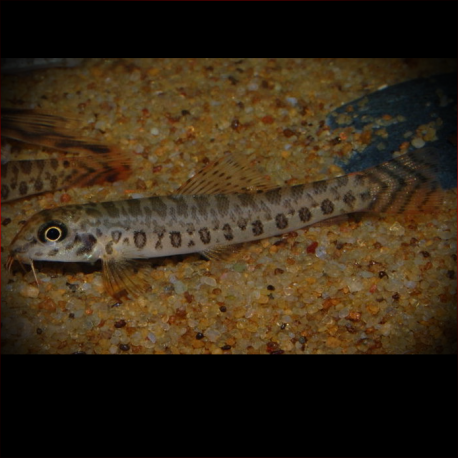Paracanthocobitis Botia
Cypriniformes Print
More info
Datasheet
| Minimum Tank Size | 90 litres / 23.78 US gallons |
| Maximum Size | 10.0cm / 3.94inches |
| Temperature | 21°C / 69.80°F - 26°C / 78.80°F |
| Hardness | 5.04dgH / 90ppm - 12.05dgH / 215ppm |
| pH | 6.0-7.5 |
General Description
The Zipper Loach (Paracanthocobitis Botia) is commonly known under various names such as 'mottled,' 'eyepot,' 'sand,' and 'striped' loach. It is considered a good choice for beginners due to its hardiness, peaceful nature, and quirky behavioral traits. The species is recognized by its characteristic ocellus, a dark marking resembling an eye at the top of the caudal peduncle, with more intensity in younger individuals. Distinct from other species, the Zipper Loach can be identified by its dark saddle-shaped markings along the dorsal surface, irregular lateral markings along the lateral line, and its unique color pattern.
Aquarium Setup
For optimal care, a tank size of at least 90 litres with ample hiding spots is recommended. The Zipper Loach thrives in setups mimicking slow-moving stream sections with a sandy substrate, water-worn boulders, and driftwood for shelter. Plants like Microsorum and Anubias can be added, with bright lighting to promote natural behavior. While high water movement is not necessary, the species can also flourish in a mature hill stream-style aquascape with rocky features.
Behaviour
This species is generally peaceful and thrives in groups of six or more, displaying more natural behavior and interactions within conspecifics. They may exhibit shy or skittish tendencies when kept alone, emphasizing the importance of group housing. In some cases, Zipper Loaches have been observed nipping at the fins of rivals, highlighting the need for appropriate tank mates and a stress-free environment.
Feeding and Diet
The Zipper Loach primarily feeds on insect larvae in the wild, but in captivity, they readily accept sinking dried foods along with live and frozen options like Daphnia, Artemia, and bloodworms. A varied diet is essential to maintaining their health and overall well-being. Ensuring a diverse food selection mimics their natural feeding habits and helps them thrive in the aquarium setting.
Reproduction & Dimorphism
Commercial breeding of the Zipper Loach is rare, with most individuals in the trade sourced from the wild. Limited reports suggest that fry have been found in well-decorated tanks, although cannibalism of eggs may occur. Male Zipper Loaches are slimmer than females and exhibit a suborbital slit absent in females, aiding in sex differentiation.
Habitat and Distribution
The Zipper Loach is native to regions such as northeastern Bengal, spanning across Pakistan, India, Nepal, Bangladesh, Myanmar, and parts of Thailand. The species favors streams, small rivers, and seasonal habitats, showing a preference for areas with leaf litter, sand, rocks, and boulders. It is part of the Nemacheilidae family and is widely distributed across Eurasia, with particular diversity in the Indian subcontinent, Southeast Asia, and China.

